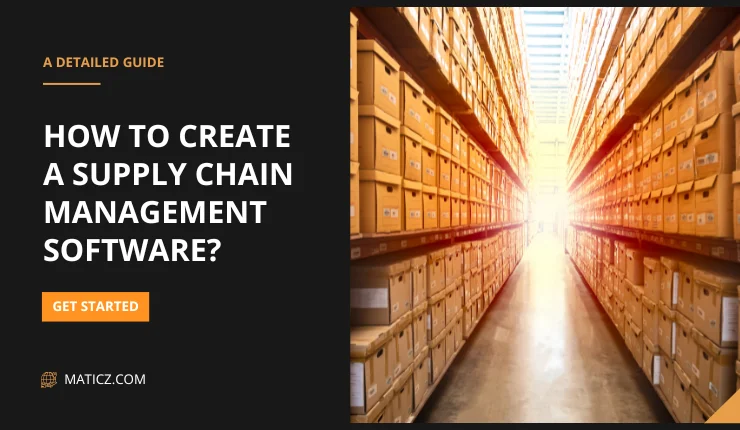Share Posts

How to Create Supply Chain Management Software?
46
2295
103
Today’s business needs simplified operations, efficient logistics, and optimized Inventory Management that suits consumers’ requirements while maintaining profitability. Incorporating robust supply chain management services can crucially improve these capabilities, but it needs careful execution and planning. Right!
Here we are going to explore the step-by-step practices to successfully integrate a supply chain management system that drives growth and efficiency.
What is a Supply Chain?
Supply chain is a process of getting a product or service taken from its raw materials to you, the customer. It works with a big team effort involving many people, organizations, resources, activities, and technology. Let's break it down:
1. Producers - They grow or make raw materials
2. Vendors - They buy and sell these materials
3. Manufacturers - They turn the raw materials into product
4. Transporters - They move these products all around the world
5. Supply Chain Managers - Manage and ensure everything runs smoother
6. Retailers - They sell their products either online or in stores
7. Consumers - They purchase and use products/services
Understanding Supply Chain Management
Before diving into the implementation steps included in the software, it is crucial to know the conceptualization of supply chain management.
Supply Chain Management (SCM) is all about making sure that everything executes smoothly from point A to point B in the journey of the product. It includes coordinating the flow of goods and services, initiating with raw materials from suppliers, then moving on to the manufacturing process, then onto distributors and retailers, and finally, they reach us, the customers.
This supply chain management assures that every step from planning and buying raw materials to production, handling stocks, and managing logistics of getting things where they need to go. Also, SCM is the backbone of how we get the products and services we need every day.
How to Develop a Supply Chain Management Software?
We at Maticz follow a chronological order of process to create Supply Chain Software. We assure you that the software we deliver is of a high-quality platform and meets the particular requirements of our clients. Let’s see the various stages of how to create a supply chain management software.
Determine Your Business Requirements
Outline the purpose and function of the digital solution
Prefer the Ideal path
Get Data Sources
Develop the Model
Align the Model
Connect the Data
Optimize the System
Analyze and Test
Evaluate the Success and Expand
Automate the Process
Determine Your Business Requirements
Before initiating your digital SCM solution, it is important to understand your business requirements. Start by highlighting the key aspects such as:
- Understand the Four Phases: Recognize the four phases of the full supply chain model.
- Determine the Ideal Stage: Identify which phase of the supply chain your software needs to concentrate on.
- Note Which Sector Needs to Improve: Pinpoint which sector needs more attention or improvement.
With these details, you can set realistic goals and determine a clear vision for your SCM software. This step assists you in choosing the right strategy for your business.
Outline the Vision and Role of Digital Solution
Next, think about how the supply chain management software will sustain your business vision and goals. Think about:
- Role: How will the supply chain software suit your current operations?
- Why: Why is a digital solution required for your business?
- Future Use: How will Software evolve as your business grows?
This clarity will assist you in planning the best approaches and choosing the right tools and resources for futuristic changes.
Prefer the Ideal Path
Determine whether to develop a comprehensive, end-to-end solution or to tackle one segment at a time. Think about:
- Dynamics of the Company: The choice relies on your company's requirements and capabilities.
- Team Input: Include proficient skill developers from various departments to understand each section's requirements and challenges.
These steps are important for guiding the development process without unnecessary complications.
Get Data Sources
We all know data is everywhere and everything which acts as the backbone of effective supply chain management. Sources data from:
- Web Data: Information from consumer websites.
- Open Data: Insights from sources such as Google Trends and more.,
- Purchased Data: Data bought from syndication sources
- IoT: Sensor data for real-time tracking.
Using accurate and highly reliable data is important to create a solid SCM business model.
Create a Model
With resources in place, it's time to develop your SCM solutions. You need to focus on the following terms:
- Integration: Combine all aspects of your plan
- Resource Management: Outline the key areas for managing resources.
- System and Tools: Determine the systems and tools used in your SCM software.
- System Links: Draft connections between various systems
Align the Model
Ensure your SCM model aligns with your business objectives:
- Create a Priority List: Determine what's important in your software
- Estimate Steps: Assess every step's importance.
- Define Tools: Choose the best SCM tools for your prior business
Connect the Data
Integrate and Connect your Data into your Hosting Solutions:
- Identify Errors: Checkout any glitches or bugs that occurred in the system after connecting and rectify
- Anticipate Challenges: Foresee the possible challenges and problems that occur in the software
- Align Objectives: Assure that data connection meets your desired goals.
Optimize the System
Enhance your Supply Chain System and data for better performance:
- Visibility: Ensure end-to-end visibility in the Supply chain business model.
- Automation: Automate the process to save your hard-earned money and valuable time.
- Adaptability: Ensure the system can adapt to changes.
Create a transparent, collaborative work ecosystem for easy data access.
Analyze and Test the Model
Beta testing or thorough testing and analysis is the important thing before deployment and after the deployment process. Using AI and ML to generate useful insights that assist you in estimating the functionality of your supply chain digital solutions:
- Plan and Strategize: Develop strategies for your SCM software.
- Effectiveness: Estimate How each supply chain tool works well.
- User Access: Test ease of access for multi-users.
- Interface Review: Assure that the user interface is more effective.
- Real-time Data: Validate that the real-time data is so accurate.
Evaluate the Success Level
Now that your supply chain software is up and running, it's time to see how it's performing well. With the insights you gather,
- KPIs: Use key performance indicators to measure success.
- RTM Metric: Assess the return on metrics to gauge the success of your model in real-time.
- Improve and Expand: Use insights to enhance and consider expanding the SCM software to meet growing business requirements.
Expand the Software Solutions
Now that SCM software is well-worked, it's time to think bigger! As your business gets enhanced, your software should grow with it. Here is how to ensure it stays adaptable:
- Check for Integration: Ensure the system can connect with various tools and systems.
- Review Technology: Identify any technology or tools that you are holding.
- Connect with Third-party Applications: Link up with other applications to improve your capabilities.
Improve the Visibility of the Model
Transparency is the key to making your supply chain more unique. It ensures that everyone involved can see and access every part of the process. Let's see how can boost visibility:
- Vendor Access: Permit vendors to access the system for better coordination.
- High-Quality Tech: Using top-notch technology to keep everything running smoothly.
- KPIs for Real-time insight: Using KPIs to observe the real-time status of the business model.
- Real-time Data: Integrate real-time data, updates, and chats for instant info sharing.
- Smart Sensors: Track products with smart sensors to stay on top of every activity.
Automate the Procedures
By automating tasks, you can keep things that move efficiently, even on the go. Here's what you can automate:
- Demand and Supply Monitoring: Keep track of supply and demand automatically.
- File Management: Store, send, and read files in an automated way.
- Dock Scheduling: Simplify scheduling for loading and unloading.
- Micro Transportation: Manage small-scale transportation more efficiently.
- Inventory Management: Automatically keeping an eye on your stocks.
Build Your Supply Chain Management Software
Developing supply chain software is important for businesses striving to achieve success in the current competitive world. By following 2024’s best and latest tech practices such as embracing cloud-native solutions, implementing Artificial Intelligence in Supply Chain, adopting Blockchain technology, and using low-code platforms, businesses can draft and deploy their highly effective SCM software.
This process improves the performance of the supply chain, drives better outcomes, and permits the achievement of strategic business goals. Are you interested in developing your supply chain? Without any hesitation, Maticz is the enthralling supply Chain management software development company that can assist you with your supply chain software requirements.
Connect with us today! We would love to hear your requirements and work with you on your supply chain management software project. 😊
Related Articles:
Tap Into the Future
The latest insights, posts, and project updates - straight to your inbox.




